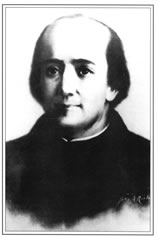We take leave of our Ilinois at the end of June, about three o'clock
in the afternoon. We embark in the sight of all the people, who admire
our little canoes, for they have never seen any like them.
We descend, following the current of the river called Pekitanoui,
which discharges into the Mississipy, flowing from the northwest.
I shall have something important to say about it, when I shall
have related all that I observed along this river.
While passing near the rather high rocks that line the river, I
noticed a simple which seemed to me very extraordinary. The root
is like
small turnips fastened together by little filaments, which taste
like carrots. From this root springs a leaf as wide as one's hand,
and half a finger thick, with spots. From the middle of this leaf
spring other leaves, resembling the sconces used for candles in
our halls; and each leaf bears five or six yellow flowers shaped
like
little bells.
We found quantities of mulberries, as large as those of France;
and a small fruit which we at first took for olives, but which
tasted
like oranges; and another fruit as large as a hen's egg. We cut
it in halves, and two divisions appeared, in each of which 8 to
10 fruits
were encased; these are shaped like almonds, and are very good
when ripe. Nevertheless, the tree that bears them has a very bad
odor
and its leaves resemble those of the walnut tree. In these prairies
there is also a fruit similar to hazelnuts, but more delicate;
the leaves are very large, and grow from a stalk at the end of
which
is a head similar to that of a sunflower, in which all its nuts
are regularly arranged. These are very good, both cooked and raw.
While skirting some rocks, which by their height and length inspired
awe, we saw upon one of them two painted monsters which at first
made us afraid, and upon which the boldest savages dare not long
rest their eyes. They are as large as a calf; they have horns on
their heads like those of a deer, a horrible look, red eyes, a
beard like a tiger's, a face somewhat like a man's, a body covered
with
scales, and so long a tail that it winds all around the body, passing
above the head and going back between the legs, ending in a fish's
tail. Green, red and black are the three colors composing the picture.
Moreover, these 2 monsters are so well painted that we cannot believe
that any savage is their author, for good painters in France would
find it difficult to paint so well,and, besides, they are so high
up on the rock that it is difficult to reach that place conveniently
to paint them. Here is approximately the shape of these monsters,
as we have faithfully copied it.
While conversing about these monsters, sailing quietly in clear
and calm water, we heard the noise of a rapid, into which we were
about
to run. I have seen nothing more dreadful. An accumulation of large
and entire trees, branches, and floating islands was issuing from
the mouth of the river Pekistanoui, with such impetuosity that
we could not with¬out great danger risk passing through it.
So great was the agitation that the water was very muddy, and could
not become
clear.
Pekitanoui is a river of considerable size, coming from the north¬west,
from a great distance; and it discharges into the Missisipi. There
are many villages of savages along this river, and I hope by its
means to discover the Vermilion or California Sea.
Judging from the direction of the course of the Missisipi, if it
con¬tinue the same way, we think that it discharges into the
Mexican gulf. It would be a great advantage to find the river leading
to the southern sea, toward California; and, as I have said, this
is what I hope to do by means of the Pekitanoui, according to the
reports made to me by the savages. From them I have learned that,
by ascending this river for 5 or G days, one reaches a fine prairie,
20 or 30 leagues long. This must be crossed in a northwesterly
direction, and it terminates at another small river, on which one
may embark,
for it is not very difficult to transport canoes through so fine
a country as that prairie. This 2nd river flows toward the southwest
for 10 or 15 leagues, after which it enters a lake, small and deep,
which flows toward the west, where it falls into the sea. I have
hardly any doubt that it is the Vermillion Sea, and I do not despair
of discovering It some day, if God grant me the grace and the health
to do so, in order that I may preach the Gospel to all the peoples
of this new world who have so long groveled in the darkness of
infidelity.
Let us resume our route, after escaping as best we could from
the dangerous rapid caused by the obstruction which I have
mentioned.
|


